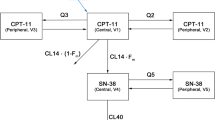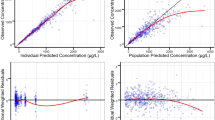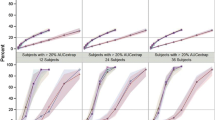Abstract
A limited sampling method for estimation of the etoposide area under the curve (AUC) is presented. The method was developed and validated in 23 patients (42 pharmacokinetic studies) with small-cell lung cancer (SCLC), limited disease. The patients received 100 mg/m2 etoposide as a 90-min intravenous infusion in combination with carboplatin, allowing for etoposide dose modification at a following course (25% increase or decrease) due to high or low nadir values for leukocytes or thrombocytes. Of the 42 pharmacokinetic studies, 27 were used in the model development and 15 were used in the model validation. Single regression analyses of the AUC versus the fitted concentrations for the model data set were performed at several time points. The analyses demonstrated high and essentially identical correlation coefficients in the interval between 2 and 21 h, with a maximal value of 0.96 being recorded at 4 h. Multiple regression analysis was then performed using fitted concentrations corresponding to 0.08–21 h. The best model for one sample was AUC =1.01x(dose level divided by 100 mg/m2)+799×C4 h, that for two samples was AUC=1.43x(dose level divided by 100 mg/m2)+544×C4 h+1756×C21 h, and that for three samples was AUC=0.07x(dose level divided by 100 mg/m2)+110×C5 min+474×C4 h+1759×C21 h. Not unexpectedly, the model validation revealed that the one-sample model was less precise than the two- or three-sample model [percentage of root mean squared error (RMSE%)=11.6%, 7.1%, and 5.4%, respectively]. All models proved to be unbiased in the validation [percentage of mean predictive error (MPE%) ±SE=4.2%±11.0%, 7.9%±6.1%, and 6.3%±5.3%, respectively]. The models were subsequently validated in 14 pharmacokinetic studies of patients with metastatic germ-cell tumours who were receiving combination chemotherapy with cisplain and bleomycin plus 100 mg/m2 etoposide as a 90-min infusion. The RMSE% was 13.4%, 10.8%, and 9.0% and the MPE%±SE was −1.0%±11.9%, 1.7%±10.5%, and 2.7%±7.9% for the one-, two-, and three-sample models, respectively. The limited sampling methods presented herein may prove to be a most valuable tool for therapeutic drug monitoring in regimens in which etoposide is given in combination with carboplatin or with cisplatin and bleomycin.
Similar content being viewed by others
References
Bennett CL, Sinkule JA, Schilsky RL, Senekjian E, Choi KE (1987) Phase I clinical and pharmacological study of 72-hour continuous infusion of etoposide in patients with advanced cancer. Cancer Res 47:1952
Brøchner-Mortensen J (1972) A simple method for determination of glomerular filtration rate. Scand J Clin Lab Invest 30:271
Calvert AH, Newell DR, Gumbrell LA, O'Reilly S, Burnell M, Boxall FE, Siddik ZH, Judson IR, Gore ME, Wiltshaw E (1989) Carboplatin dosage: prospective validation of a simple formula based on renal function. J Clin Oncol 7:1748
Conley BA, Forrest A, Egorin MJ, Zuhowski EG, Sinibaldi V, Van Echo BA (1989) Phase I trial using adaptive control dosing of hexamethylene bisacetamide (NSC 95 580). Cancer Res 49:3436
Egorin MJ, Forrest A, Belani CP, Ratain MJ, Abrams JS, Van Echo DA (1989) A limited sampling strategy for cyclophosphamide pharmacokinetics. Cancer Res 49:3129
El-Yazigi A, Martin CR (1987) Improved assay for etoposide in plasma by radial-compression liquid chromatography with electrochemical detection. Clin Chem 33:803
Freedman LS, Workman P (1988) When can the infusion period be safely ignored in the estimation of pharmacokinetic parameters in humans? Cancer Chemother Pharmacol 22:95
Hande KR, Wedlund PJ, Noone RM, Wilkinson GR, Greco FA, Wolff SN (1984) Pharmacokinetics of high-dose etoposide (VP-16-213) administered to cancer patients. Cancer Res 44:379
Henwood JM, Brogden RN (1990) Etoposide. A review of its pharmacodynamic and pharmacokinetic properties, and therapeutic potential in combination chemotherapy of cancer. Drugs 39:438
Jakobsen P, Steiness E, Bastholt L, Dalmark M, Lorenzen A, Petersen D, Gjedde S, Rose C, Nielsen OS, Mouridsen HT, Jakobsen A (1991) Multiple-dose pharmacokinetics of epirubicin at four different dose levels: studies in patients with metastatic breast cancer. Cancer Chemother Pharmacol 28:63
Joel SP, Heap L, Robbins S, Clarke PI, Slevin ML (1990) A limited sampling strategy for the calculation of etoposide pharmacokinetics (abstract). Proc Am Soc Clin Oncol 9:260
Miller AA, Stewart CF, Tolley EA (1990) Clinical pharmacodynamics of continuous-infusion etoposide. Cancer Chemother Pharmacol 25:361
Newell DR (1989) Pharmacokinetic determinants of the activity and toxicity of antiumour agents. Cancer Surv 8:557
Ratain MJ, Vogelzang NJ (1987) Limited smapling model for vinblastine pharmacokinetics. Cancer Treat Rep 71:935
Ratain MJ, Staubus AE, Schilsky RL, Malspeis L (1988) Limited sampling models for amonafide (NSC 308 847) pharmacokinetics. Cancer Res 48:4127
Ratain MJ, Schilsky RL, Choi KE, Guarnieri C, Grimmer D, Vogelzang NJ, Senekjian E, Liebner MA (1989) Adaptive control of etoposide administration: impact of interpatient pharmacodynamic variability. Clin Pharmacol Ther 45:226
Ratain MJ, Robert J, Vijgh WJF van der (1991) Limited sampling models for doxorubicin pharmacokinetics. J Clin Oncol 9:871
Santini J, Milano G, Thyss A, Renee N, Viens P, Ayela P, Schneider M, Demard F (1989) 5-FU therapeutic monitoring with dose adjustment leads to an improved therapeutic index in head and neck cancer. Br J Cancer 59:287
Sheiner LB, Beal SL (1981) Some suggestions for measuring predictive performance. J Pharmacokinet Biopharm 9:503
Sørensen BT, Strömgren A, Jakobsen P, Jakobsen A (1993) A limited sampling method for the estimation of the carboplatin area under the curve. Cancer Chemother Pharmacol 31:223
Stoller RG, Hande KR, Jacobs SA, Rosenberg SA, Chabner BA (1977) Use of pharmacokinetics to predict and prevent methotrexate toxicity. N Engl J Med 297:630
Werkhoven-Goewie CE, Brinkman VAT, Frei RW (1983) Automated liquid chromatographic analysis of the antitumorigenic drugs, etoposide (VP16-213) and teniposide (VM26). J Chromatogr 276:349
Wolff SN, Grosh WW, Prater K, Hande KR (1987) In vitro pharmacodynamic evaluation of VP-16-213 and implications for chemotherapy. Cancer Chemother Pharmacol 19:246
Author information
Authors and Affiliations
Additional information
Supported by grants from the Lundbeck Foundation, the Research Foundation of the Oncology Department in Aarhus, and Asta and Peter Gøtz-Petersen's Foundation
Rights and permissions
About this article
Cite this article
Strömgren, A.S., Sørensen, B.T., Jakobsen, P. et al. A limited sampling method for estimation of the etoposide area under the curve. Cancer Chemother. Pharmacol. 32, 226–230 (1993). https://doi.org/10.1007/BF00685840
Received:
Accepted:
Issue Date:
DOI: https://doi.org/10.1007/BF00685840




